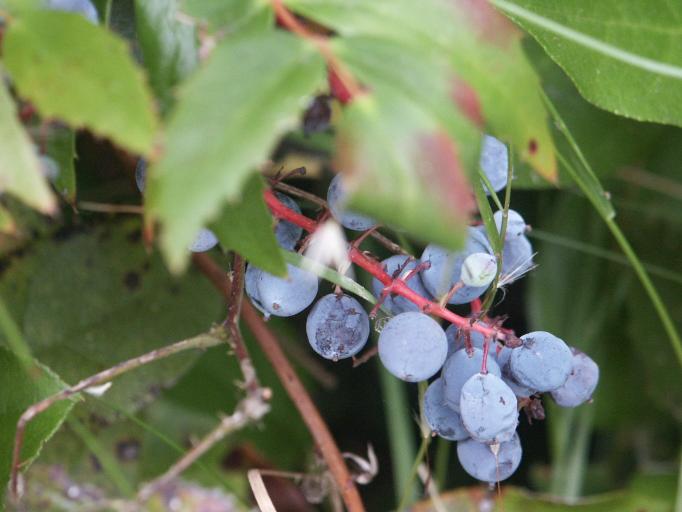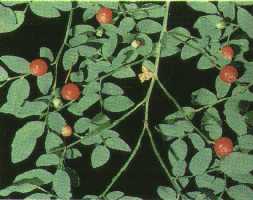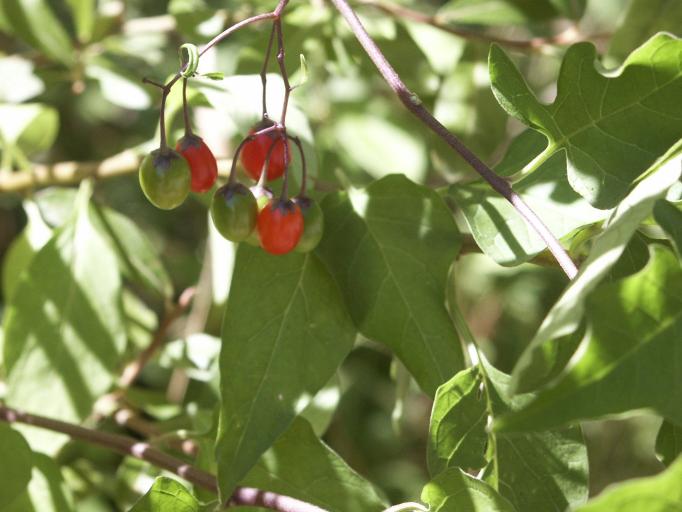
(Rubus spectabilis)

(Rubus parviflorus)

(Rubus leucodermis)

(Rubus ursinus)

(Rubus discolor)

(Gaultheria shallon)

(Mahonia nervosa)

(Vaccinium parvifolium)

(Oemleria cerasiformis)

(Ribes lacustre)
(Ribes bracteosum)
There are 23 species of native plants, mostly shrubs, which produce a berry or berry-like fruit. Many are edible and choice, some are not edible which means they taste bad, are mostly seed, or for some reason people don't eat them. We have two berries, the bane berry, and the red nightshade which are poisonous. The many berry producing plants we have encourages the many berry eating birds which summer here.
Before consuming berries you do not know, it is wise to consult with someone like Heidi, Rob, or Jack to confirm the identity. Also, Plants of the Pacific Northwest Coast by Pojar and Mackinnon has good information. I listed the abundance of plants using the following scale: Common, they are widely spread in more than 15 locations, Uncommon, they are restricted to a fewer than 15 locations but still obvious enough to find, Rare they are scarce and hard to find, less than 10 are known.
 |
Salmonberry
(Rubus spectabilis) |
Edible. Fruits late May through July, ripe berries, orange to salmon color, pull off easily. Tall bush 6-8 feet, leaves alternate, leaflets typically in 3, bark with scattered thin prickles, older bark brown and shredding. Common. Found in semi-shaded areas such as along the roads. Local native Americas found the new shoots of this in spring were considered a welcome break from winters food. |
 |
Thimbleberry
(Rubus parviflorus) |
Edible. Fruits July. Dome shaped berries, red when ripe, pull off a core. Mushy, do not keep well, better for jams and sauce than eating. Bush 3-6 feet tall, forming thickets, leaves soft, large and maple-like. Common, found in clearings, along road edges. The large, soft leaves of this plant are also called woodsman's toilet paper. |
 |
Black Cap Raspberry
(Rubus leucodermis) |
Edible. Fruits July-August. Ripe when deep red or black, pull off a central core. Plant usually single or few stems, white with curved, flat thorns. Leaves in 3, alternate similar to salmonberry and blackberries. Uncommon. Found in scattered locations that get sunshine, Big Island. |
 |
Trailing Blackberry
(Rubus ursinus) |
Edible. Berries small, black when ripe. July-August. Plant a long vine like growth, low but often climbing over stumps or other bushes. 3 leaflets. Common. Found all over Sharingwood, best berries in sunny locations. Loggers call these plants ankle saws because their vine-like form makes them easy to trip over and when you do the prickles tear your skin. |
 |
Himalayan Blackberry
(Rubus discolor) |
Edible. Berries large and juicy, black when ripe. Late July-Sept. Plant large vines, often climbing over other plants, with stout thorns. leaves alternate in 3s- sometimes 5's. Uncommon. Found in a few locations in Sharingwood, several along road at entrance. This is an aggressive and invasive weedy shrub, often forming large, dense, impenetrable thickets in areas with enough sun. |
 |
Salal
(Gaultheria shallon) |
Edible. Berries purplish-black, in groups on their own small stem. Late July-Sept. Plant has thick leathery leaves, usually forming dense thickets. Uncommon. Found primarily on Pirate Island, and a few other locations scattered around Sharingwood. This plant was a primary winter food for the coastal tribal peoples, who gathered them in large baskets then pressed and dried them in 3 foot long cakes. |
 |
Oregon Grape
(Mahonia nervosa) |
Edible. Berries Powder blue, in groups. Late May-July. Plant low, leathery leaves with many sharp points, holly-like. Common. Found in areas with abundant sun, big island, pirate island, east woods. The roots of this plant make a strong yellow dye. |
 |
Red Huckleberry
(Vaccinium parvifolium) |
Edible. Berries small and red, tart. Late June-Sept. Plant typically grows on stumps or other decaying wood, green angular stems. Common. Found throughout Sharingwood. |
 |
Indian Plum
(Oemleria cerasiformis) |
Edible. Berries powder blue-black when ripe, hanging in clusters. Late May-June. Plant has alternate leaves, 4 times longer than wide, broadest toward end. Grows in mixed sunny areas. Uncommon outside of housing area, found in scattered locations mostly along swamp and east forest. This is the first shrub to flower in spring, male and females on different plants. |
 |
Black Gooseberry
(Ribes lacustre) |
Edible. Berries dark purple-black, shiny, usually in clusters. July. Plant typically low and sprawling, densely spiny with larger thorns where leaves join stem. Rare. In scattered locations with enough sun. |
| Stink Currant
(Ribes bracteosum) |
Edible but varied flavor. Berries slightly oblong and powder blue in clusters. Late July-August. Plant 3 feet tall with large maple-like leaves. Rare. In east woods and swamp area. |
 |
Bitter Cherry
(Prunus emarginata) |
Not Edible, very bitter. Fruits red sometimes translucent. Large pit. Late May-June. A tree with oval leaves, dark gray bark with horizontal bands. Common, south and east forests, commonhouse. This fruit is adored by birds, especially Robins who plant them everywhere with their droppings. |
 |
Devils Club
(Oplopanax horridus) |
Not Edible, Berry red, bitter and mealy with large seed. Fruits in large cluster at top of plant. July. Plant with large maple-like leaves and densely spiny stems. Uncommon. forests, phase 2 parking area. This plant indicates a high water table. |
 |
Snow Berry
(Symphoricarpos albus) |
Not edible. Berry white, bland, insipid. July-Oct, fruit often hangs on until late winter after leaves fall. Plant with varying non-uniform, opposite leaves. Often forms thickets. Rare, a few around developed areas, and in swamp. |
 |
Black Twinberry
(Lonicera involucrata) |
Not Edible, bitter. Berry black, in pairs on reddish bracts. Plant 5-7 feet tall, leaves opposite, lance shaped, pointed. Rare, in swamp along boardwalk trail. |
 |
Red Elderberry
(Sambucus racemosa) |
Not Edible. Can give diarrhea. Berries tiny in pyramidal clusters. July. Plant has opposite leaves with 7-14 leaflets. Grows in areas with mixed sun and shade. Common, Found throughout Sharingwood along roads and trails. |
 |
Red-Flowering Currant
(Ribes sanguineum) |
Not Edible. Berries Blue-black in clusters on stem, often slightly hairy, large seed. Plant 5-7 feet, 3-part leaves, grows in semi-sunny areas, vivid red flowers in April.. Common in developed area, uncommon in woods. |
 |
Cascara
(Rhamnus purshiana) |
Not edible. May cause stomach ache or diarrhea. Berries black, numerous. July-Aug. Tree with alternate glossy green leaves, strongly viened. Common in developed area, uncommon in woods. Commonhouse. The gray bark of this tree contains a powerful laxative, and the berries contain smaller amounts of this same property. |
 |
False Lilly of the Valley
(Mianthemum dilatum) |
Not edible. Berries greenish with brown spots then later turning reddish. Herbaceous plant forming a low ground cover in the forest with heart shaped leaves. Common. Found throughout the Sharingwood forest. |
 |
Red-Osier Dogwood
(Cornus stolonifera) |
Not edible. Berries white, sometimes with blue tinge. Bitter. Thick shrub with opposite leaves with prominent veins and red stems. Rare. Found in a few places in the wetland. A favorite of robins and other berry eating birds. |
 |
Orange Honeysuckle
(Lonicera Ciliosa) |
Not Edible. Bitter. Berries orange red, small in bunches. Plant a vine, with fused, opposite leaves. Uncommon, found mostly around developed areas. |
 |
Bane Berry
(Actaea rubra) |
Poisonous. Deadly. Berries in cluster on stalk low to ground, glossy red when ripe, greenish unripe. Herbaceous plant, low to the ground. Leaves alternate, deeply toothed, sometimes 3's, slightly glossy. Rare, in east woods, may have only 3-4 berries. |
 |
Bane Berry Leaves | Leaves of the Bane Berry. |
 |
Red Nightshade
(Solanum dulcamara) |
Poisonous. Will make some people quite ill, toxins can effect nervous system, causing breathing and cardiac problems. Berries translucent red, oval shaped. Plant a creeping vine with alternate leaves that are heart shaped. Uncommon in developed area, along road near campground trail. This plant is also known as Eurpean Bittersweet and is also confused with deadly nightshade which has black berries. |